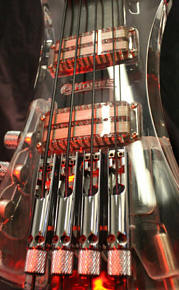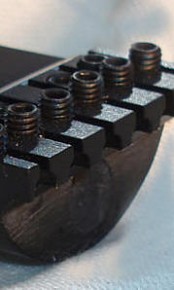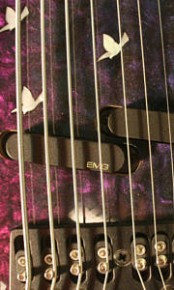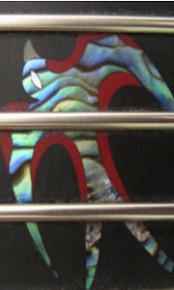THE FOLDED TUBE
Given a tube of uniform cross-section, produce a finished tubular form tapered in diameter from one end the other. The overall tube wall composition and thickness may vary, dependent on the required stiffness and other characteristics required of the final product.
Background:
A uniform cross-section tube may be made using extrusion, pultrusion and filament winding. A nonuniform tube may be made only by filament winding. Pultrusion is most cost-effective for producing a maximally stiff beam utilizing a continuous strand fibrous material. Extrusion is not suitable for production of a tube which contains continuous strain fiber in tension. Filament winding is suitable for producing a stiff tubular beam. Both pultrusion and filament winding are suitable for producing the folded tube. Pultrusion is most cost-effective when it can successfully produce the desired finished cross-sections. Filament winding is a viable second choice for other finished cross-sections.
Finished folded tube beam base material parameters:
As appropriate for final outcome, the first choice for the pre-reform tube is to produce a tube of uniform cross-section, using pultrusion.
Where the required finished cross-section cannot be achieved with a pre-form tube of uniform dimension, a tapered tube is used. This tube may be a braided fiber pultruded tube that has been ‘pulled/stretched’ along its longitudinal axis as a secondary operation. Alternately it may be produced by filament winding.
In all cases the pre-form is comprised of a continuous strand parallel tow carbon fiber core . This may be skinned with an off-axis braided fiber exterior.
Material composition is to be approximately 65% carbon fiber, 35% thermoplastic resin by weight.
Uniform wall thickness will range from 0.100” to 0.250”.
Choice of pre-form tube cross-section:
A pre-form tube of uniform cross-section may be re-formed to longitudinally tapered final forms based on proportional calculations of the target final overall length and cross-sectional dimensions.
The range of full finished beam length tapers (by example: tube end diameters of 1.5” and 2.75” over a 36.0” length) is dependent on the relationship of the final depths, intermediate diameters and radii required for the tubes post-formed shell exterior.
Regarding producing the required finished outside dimensions of a tapered tube:
Normally, as the target width at the narrow width end of a post-formed tube decreases, the depth increases. By example, the outcome might look like a vertically oriented oval. taller than wide. To produce a more minimized overall finished outside ‘circumference’, an ‘internal’ fold is produced within the tube. At the opposing end of this folded tube, the maximum width with minimum depth may be achieved by pulling the tube sideways in order to produce a oblong, flatter cross-section. Essentially, the tube depth decreases as it increases to its maximum width. When a less wide final dimension is required at this wider tube end, an internal fold is also produced. The amount of internal fold at the wide end is independent but connected to that at the narrow end.
Production:
1) An oven of appropriate dimensions for final product yield is used. A pre-formed tube of uniform or tapered cross-section and having the capacity to produce the proper cross-sections of the folded tube’s wide end final shape, is placed on a properly sized rod mount. The rod serves as a base plate for holding the tube in position with in the oven. The rod also serves as the element that will form the internal fold. Thus, this rod’s top surface shape is that of the final post-formed beam underside/interior.
2) Two upper rods (puldrel’s) of uniform cross-section and two to-the-side and lower puldrel’s of tapered cross-section are placed inside and through the entire tube length, with each end extending beyond the tube end openings. The two tapered puldrel’s may be prefabricated relief-adjusting truss rod units and may be left in the post-formed tube. When appropriate the upper puldrels may hold a tapered, uniform or compound radiused plate representing the final radii of an adjoining outside face. This plate will then produce the shape of the outside folded tube face that is adjacent to it. The plate will be held by the uniform cross-section puldrel’s throughout the forming process.
3) In order to produce the final folded tube shape, automated cam mechanisms are located at each end of the base plate rod. They are attached to both the base plate and to the puldrels. The shape of the cam plates are designed to guide the puldrels into specific final locations within the tube. Each puldrel will be pulled along and around the guides surface after the tube is heated to a softened and flexible state. Each puldrel will be moved into final position by activation of either a ‘loaded’ spring, or by a hydraulic or servo mechanism. The final puldrel end locations are based on the position that each puldrel needs to be in order to pull that end of the tube into its final shape. Through the action of pulling and relocating the puldrels at both ends of the tube, all points and cross-sections along the length of the post-shaped folded tube will represent the location of that part of the specific puldrel. The tubes taper along the length of each puldrel will be even and uniform. Additionally, the curvature of the outside circumference along the post folded tube will be uniform ‘between’ the puldrels and the base plate rod.
4) The oven, and thus the tube and folding mechanism is heated uniformly to the minimum temperature required of the thermoplastic used, with air flow provided through the tube interior.
5) The cam-operated mechanisms are activated, moving through a specific predetermined arced path pulling/reshaping the tube to its post-form configuration. During this step, end plugs that will stabilize the re-formed tube openings are inserted into the tube ends around the puldrel’s. These end caps may serve as elements of attachment during later steps in the production of the finished product.
6) The folded tube, held by the mechanism is removed from the oven and cooled to a solid state, circa room temperature.
7) The mechanism is detached. The puldrel’s are removed all appropriate. The base plate rod is then detached as the part is removed from the base plate rod.
Subsequent steps for end product production may include:
1) Attachment of prefabricated elements to the tube ends.
2) Attachment of elements to the external circumference / tube sides along the length of the folded tube.










